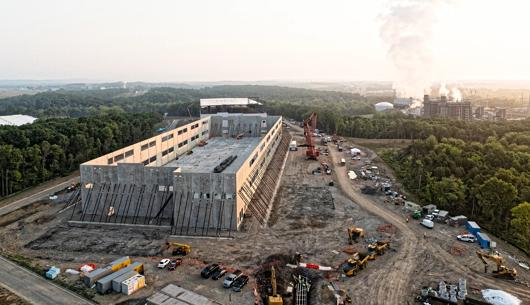Construction needs to do more to reduce carbon emissions
More needs to be made of these procurement routes, with clients honouring the original concept rather than watering down concepts.
As the Prime Minister says in his forward to the government’s Net Zero Strategy: “In 2050, we will still be driving cars, flying planes and heating our homes, but our cars will be electric gliding silently around our cities, our planes will be zero emission allowing us to fly guilt-free, and our homes will be heated by cheap reliable power drawn from the winds of the North Sea.”
However, we’re in 2021 and this utopia requires an innovative construction sector to lead the way in driving down emissions and the research, design and development of technologies and infrastructure which doesn’t yet exist.
The National Engineering Policy Centre’s (NEPC) October 2021 report Decarbonising Construction says that if urgent action is not taken at pace and scale, the construction process will jeopardise attempts to meet the net zero target by 2050.
What’s the law got to do with it?
It comes down to the “carrot” or “stick” approach.
By this we mean the introduction of incentives to promote innovation and the achievement of targets (the carrot), while on the other hand, some say legislation is required to force dramatic change – with penalties or restrictions for those who don’t comply (the stick).
A “stick” approach may be inevitable for isolated pockets of the sector, such as the government’s announcement on 22 November that all new homes and buildings such as supermarkets and workplaces will be required to install electric vehicle charge points from next year. However, given the broad nature of the sector and the significant challenge we face, it may be impractical to solve the problem with legislation such as this. Further, a “stick” approach risks stifling the sector at a critical time in the build back from Covid and the global demand on resources.
Instead, the “carrot” approach will allow innovation to flourish in the right legal framework, which needs to be supplemented with central government procurement practices and local government coordination. A common framework of expectations is required so that there is consistency across government procurement.
On 30 September, the government announced new rules that require all companies bidding for government contracts worth more than £5m a year to commit to net zero climate goals. It is likely to only be a matter of time that this flows down to other areas of the economy.
Peter Ware, partner and head of government sector at Browne Jacobson, commented: “With more of a two-way conversation and a bit more thought by public sector buyers as to what the public sector need is, particularly what help they need to achieve their own goals, greater success can happen. Collaboration and partnership can achieve so much more than just each company paddling their own canoe.”
It wasn’t too long ago that government mandated the use of BIM on all public sector projects and we had the BIM Task Group working on consistency with BIM and data standards. The industry adapted to incorporate such requirements into its contractual frameworks which are now standard.
The legal framework – introducing carrots
The profit margins and risks associated with contracting mean there’s not enough incentive in “one-off” projects to encourage innovation and decarbonisation. There is a general acceptance that whatever the solution the supply chain needs to work together to achieve net zero but are the carrots big enough to drive real change?
We already have the legal contracts to achieve integrated supply chains focused on achieving a common objective. Contracts such as the NEC Alliance Contract, with its integrated risk and reward model, and the ACA Term Alliance Contract (TAC-1) and Framework Alliance Contract (FAC-1), where the focus is on agreed objectives, success measures, targets and incentives.
Such “targets” and “objectives” can be based on decarbonisation. Long-term frameworks from government using these types of contracts incentivise the entire supply chain to collaborate and provide the exclusivity needed to invest in research and development of decarbonisation technology, materials and methods. It also avoids the risk of anti-competitive behaviour.
More needs to be made of these revolutionary procurement routes, with clients honouring the original concept rather than watering down the concepts that truly promote collaboration and the focus on objectives.
It is now accepted that the impact of embodied carbon in existing buildings is a significant factor when assessing the carbon impact of construction. With these alliance construction procurement models, led by central and local government, we could see the supply chain being incentivised not to build but instead to refurbish and, over time, to innovate the technology to enhance the options for refurbishment projects and the recycling of materials.
Contact

Michael Sadler
Partner
michael.sadler@brownejacobson.com
+44 (0)115 976 6599







































